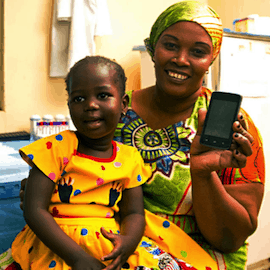The Complex Truth of Health Tech: Why Greater Ultrasound Availability Doesn’t Always Benefit Patients
Advances in health technologies have reshaped the lives of communities, families and individuals, undoubtedly contributing to better health outcomes around the world. For the most vulnerable populations, technology may significantly improve access to preventive, diagnostic, and treatment services and help increase demand for greater quality care. Yet, despite their potential, new technologies can also add new challenges, risking potential gains in quality, safety or cost. Particularly in settings where health systems are weak, the introduction of technological interventions requires thoughtful execution.
Take the case of ultrasound technology. Used during routine antenatal visits, ultrasound scans have the potential to change the scenario for many pregnant women who face complications. If combined with proper skills, knowledge and quality-assurance, this technology could help identify high-risk pregnancies and establish an accurate gestational age in order to improve obstetric care. Many low- and middle-income countries are seeing a rapid introduction of this technology into their health systems, accelerated by a dramatic rise in demand that has been driven in part by medical staff, local advertising, falling prices, and a greater availability and range of ultrasound devices.
Yet ultrasounds are not proven to lead to better outcomes for women and newborns in low-income countries, and without the proper focus on their introduction and use, we risk the efficiency and effectiveness of health systems and expose women and newborns to unnecessary technological interventions. That’s why, just last year, the World Health Organization (WHO) issued recommendations on antenatal care endorsing one scan in early pregnancy in low-income countries alongside guidance for staff training and proper use of this technology.
The realities on the ground
We recently visited a health center in the outskirts of Kampala, Uganda’s capital city, which had just introduced an ultrasound machine for antenatal care. Like many others, the doctor at this health center was looking to take advantage of this imaging technology to provide better care to his patients. Despite the guidelines calling for only one ultrasound scan in early pregnancy, a woman we met proudly shared with us four photographs she obtained through repeated scans, even though there were no abnormalities or issues identified throughout her pregnancy. We’ve encountered instances like these in several countries, bringing into question essential governance aspects including the right policies, oversight, and mechanisms for evidence-based decision-making, and highlighting potential ethical issues around the use of this technology. Was the doctor equipped with the right skills or understanding behind the proper use of ultrasound? Were there additional unnecessary costs and burdens for the woman and her family, who may have been lulled into a false sense of security that repeated scans would ensure a better outcome for mother and baby?
Given the WHO recommendation and the ubiquity of ultrasound devices, the real question becomes: How do we ensure health systems are robust enough to effectively and safely take advantage of this technology?
There appear to be major gaps in policies, planning and oversight to support the introduction of ultrasound technology, especially outside the more specialized hospital setting. At Management Sciences for Health we support governments in their efforts to build strong adaptive systems that meet the needs of the populations they serve. The case of antenatal ultrasound highlights three specific issues:
Adequate procurement and a strong supply chain: Our experiences in helping governments improve procurement and supply chain management highlight critical issues that affect how technology takes root and delivers on its potential. Ultrasound technology has advanced to allow for different types of imaging and functionalities, ranging in price from USD $2,000 to $15,000. Determining which one meets the specific needs of a local health system requires thoughtful procurement policies and effective distribution and placement. In addition to regular supplies such as jelly, paper towels, printers, etc., the processes and costs required to maintain the accuracy and sensitivity of the ultrasound equipment, including servicing malfunctioning machines, must be carefully considered within health systems – and these are influenced by the machine specifications. Of course, power supply requirements are also important considerations for health centers that frequently experience electricity outages and voltage fluctuations.
A well-functioning referral mechanism: Because the effectiveness of this intervention relies on the ability of screened women to seek care depending on the screening results, it is also essential for a functional referral system to be in place. Health workers and sonographers must be able to support informed decision-making, and women with high-risk pregnancies must be able to reach the referral hospital – one which must be equipped to handle the level of care that screening indicates, including emergency obstetric and newborn care. The value of the ultrasound screening is diminished when this is not in place, or when women are unable to cover the additional costs of transportation and hospital care and treatment. As illustrated in a study published recently on the implementation of ultrasound technologies in the Democratic Republic of Congo, these challenges represent enormous barriers for the most vulnerable populations.
Strong governance for health: As a screening tool, the ultrasound depends on a process or a decision-making algorithm that allows health workers to adequately act on the information gathered. Nurses and midwives – the cadres who might typically perform this intervention at health centers – must have the policies, consistent training and ongoing supervision to use the technology, analyze the results and take appropriate actions. These elements, and a sound system of quality assurance and data management, will protect the health of women and newborns and prevent health workers from misdiagnosing patients.
Above all, to realize the power of technology in any setting, but most importantly in low-resource countries, we must understand their specific circumstances, and support governments to establish appropriate policies, good governance, and ethical standards as a foundation for appropriate use of technology. This requires structural changes within the health system, and partnership with businesses involved in the manufacturing and selling of ultrasound devices. Only then can we ensure that ultrasound technology – or any technology – delivers on its promise.
Photo by Rui Pires, Uganda.
Homepage photo credit: U.S. Air Force photo/Airman 1st Class Ryan Conroy
Catharine Taylor is the vice president of the Health Programs Group at Management Sciences for Health, a leading global health NGO dedicated to building stronger health systems.
Dai Hozumi is Senior Director for Health Technologies at Management Sciences for Health.
JoAnn Paradis is a strategic communications advisor at Management Sciences for Health.
- Categories
- Health Care, Technology



